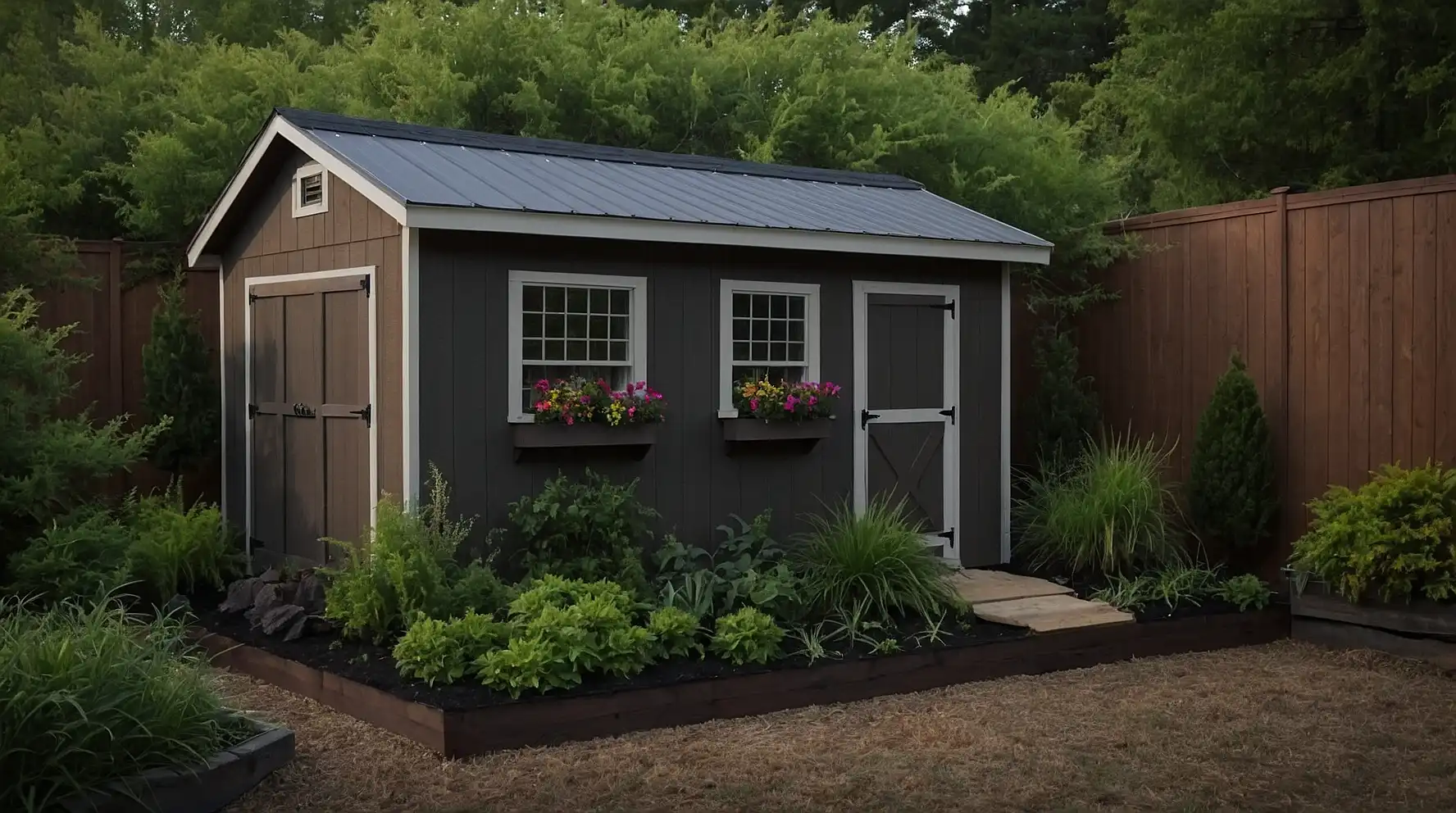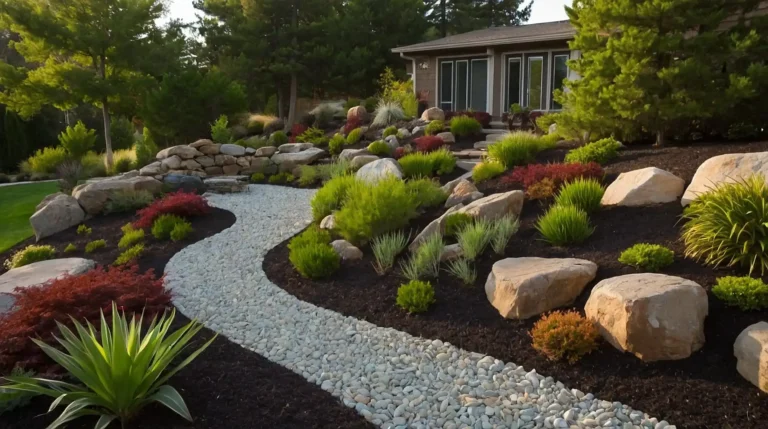29 Shed Landscaping Ideas
Your shed doesn’t have to be an eyesore in your backyard. Smart landscaping makes sheds blend seamlessly with existing garden designs.
These creative landscaping ideas transform utilitarian storage buildings into attractive focal points that enhance your entire outdoor space.
You’ll discover budget-friendly solutions that add visual appeal while maintaining functionality.
These practical approaches work for any shed size or yard layout. Ready to turn your storage space into a landscape asset?
1: Foundation Planting Border
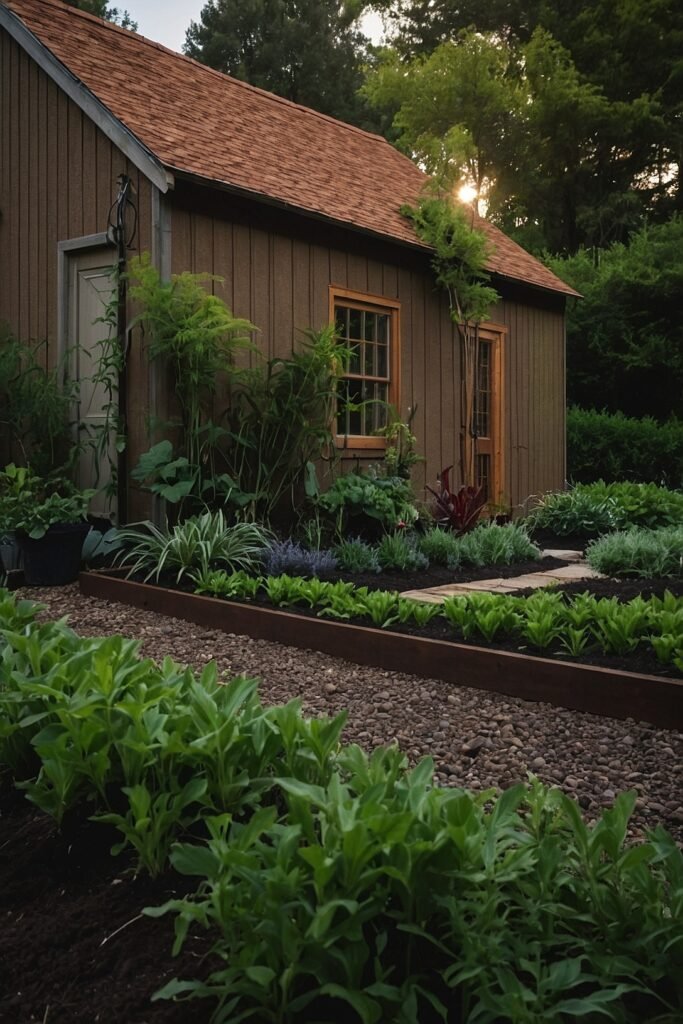
Create a perennial flower border around your shed’s foundation to soften harsh edges and integrate the structure naturally.
You establish visual continuity between building and landscape. Leave adequate space between plants and shed walls for air circulation.
Choose plants with varying heights and bloom times for year-round interest. Place taller specimens at corners and shorter ones along walls.
This foundation treatment transforms stark buildings into garden-integrated features.
2: Climbing Vine Trellis System
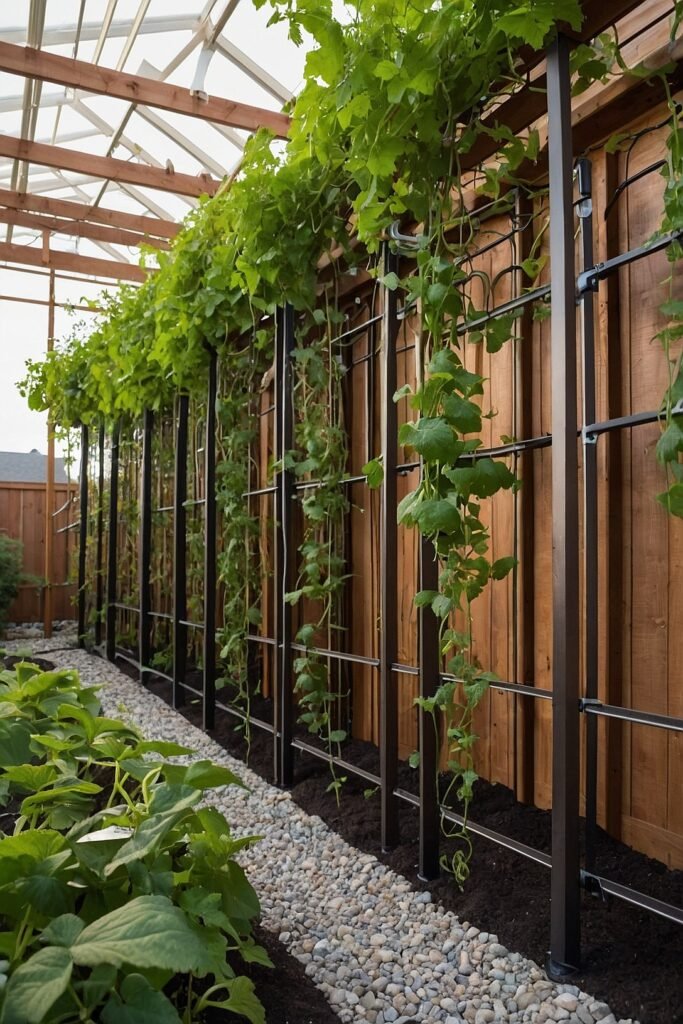
Install trellises or wire systems on shed walls for climbing plants like clematis or morning glories.
You create living walls that provide natural camouflage and seasonal beauty.
Choose vines that won’t damage siding or create moisture problems against building surfaces. Position trellises several inches from walls for air circulation.
Select flowering or foliage vines based on your desired aesthetic. Climbing plants add vertical interest while screening utilitarian shed appearance effectively.
3: Gravel Pathway Integration
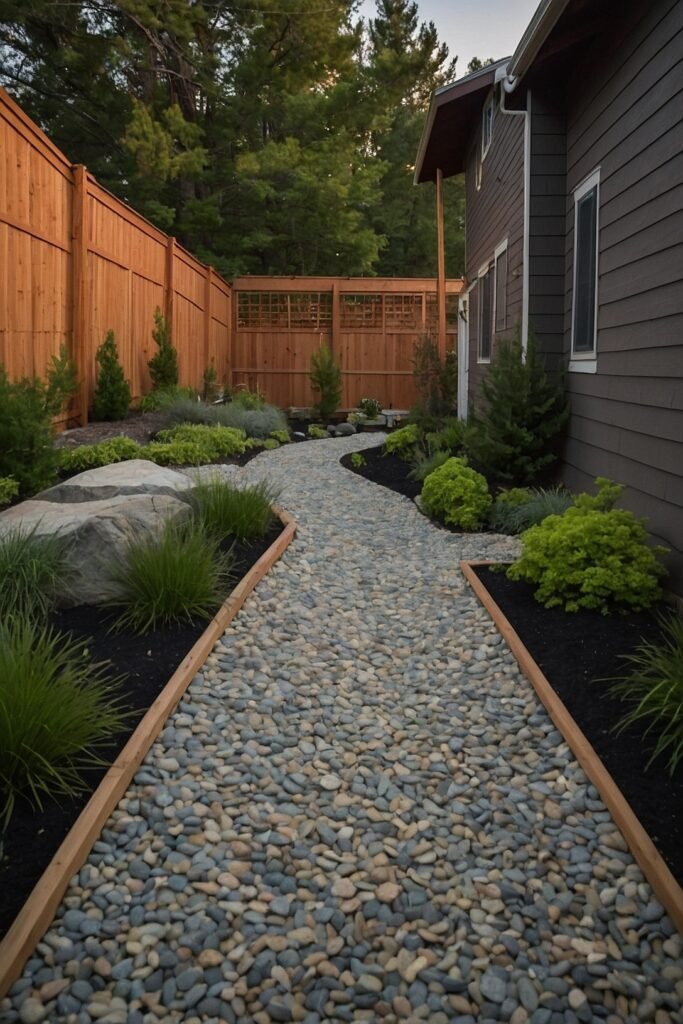
Design decorative pathways leading to your shed using colored gravel, stepping stones, or brick patterns.
You create functional access while adding visual appeal to the route. Ensure pathways provide stable footing during all weather conditions.
Choose materials that complement your home’s architecture and existing landscape features.
Edge pathways with plants or decorative borders for finished appearance. Well-designed access routes make sheds feel like intentional landscape elements.
4: Raised Flower Bed Surrounding

Build raised planting beds around your shed perimeter using stone, brick, or timber retaining walls.
You create defined growing spaces while elevating the shed’s landscape presence.
Fill beds with quality soil for optimal plant growth and drainage. Choose plants appropriate for your shed’s sun and moisture conditions.
Vary bed heights and widths for dynamic visual interest. Raised beds provide better drainage while creating structured garden spaces around buildings.
5: Seasonal Container Garden Display
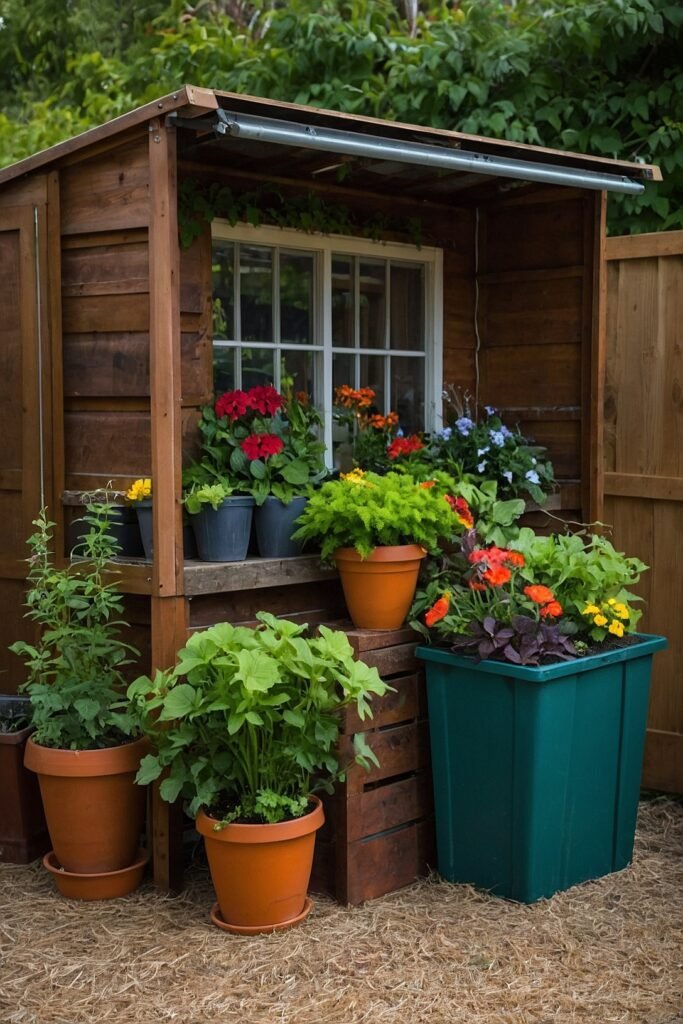
Arrange large planters and containers around your shed entrance for flexible seasonal decorating options.
You change displays throughout the year without permanent plant installations.
Group containers in odd numbers for pleasing visual arrangements. Use various sizes and materials that coordinate with your shed’s style.
Plant containers with seasonal flowers, herbs, or small shrubs. This approach allows creative flexibility while softening shed appearance with living elements.
6: Privacy Screen Planting
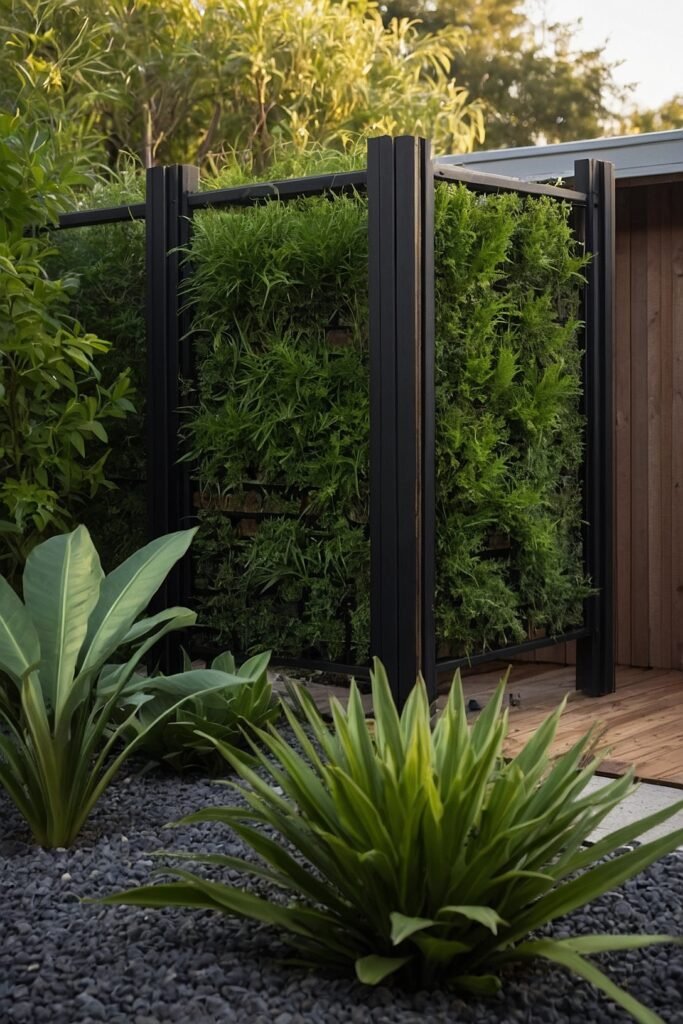
Plant fast-growing shrubs or install decorative fencing to screen your shed from main viewing areas.
You maintain functionality while minimizing visual impact on landscape design. Position screens to block views from frequently used outdoor spaces.
Choose evergreen plants for year-round screening or deciduous options for seasonal variation.
Consider mature plant sizes when spacing for proper coverage. Strategic screening integrates sheds into landscapes without dominating outdoor room compositions.
7: Coordinated Color Scheme

Paint your shed in colors that complement your home and garden palette for cohesive landscape design.
You create visual harmony throughout your entire outdoor space. Choose colors that blend with natural surroundings or accent existing structures attractively.
Consider how colors appear in different lighting conditions throughout seasons.
Use trim colors to add visual interest while maintaining overall coordination. Thoughtful color choices make sheds feel like planned architectural elements.
8: Lighting Feature Installation
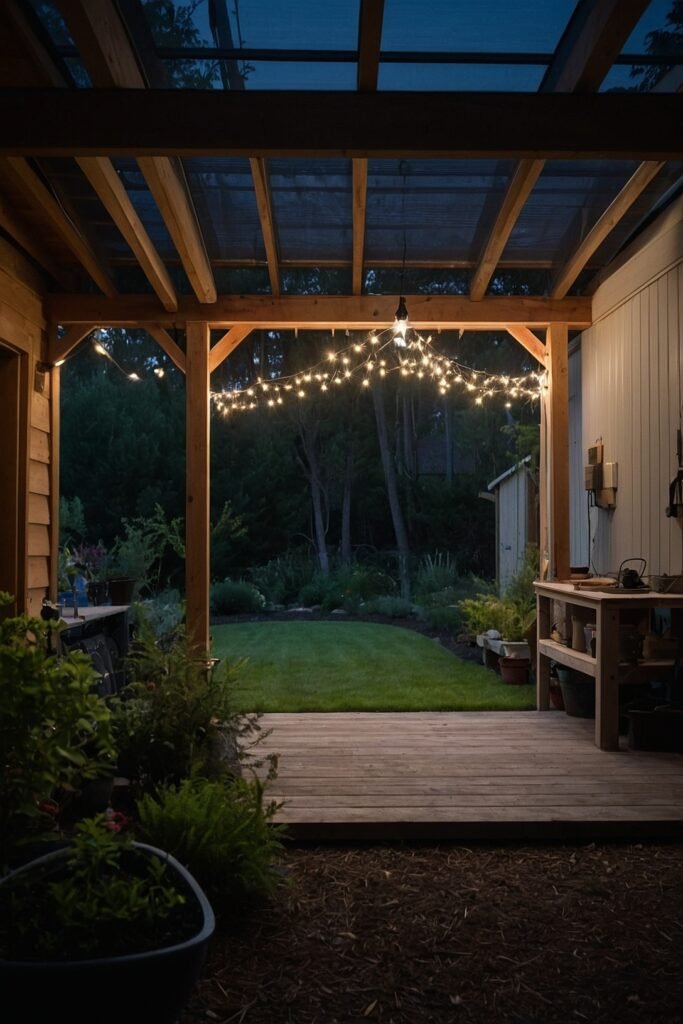
Add landscape lighting around your shed for evening ambiance and improved functionality during dark hours.
You extend usable time while creating attractive nighttime focal points. Use solar options for easy installation without electrical work.
Install path lights leading to shed entrances and accent lights highlighting architectural features.
Choose fixtures that match your overall landscape lighting theme. Proper illumination makes sheds safer to access while adding magical evening atmosphere.
9: Herb Garden Integration
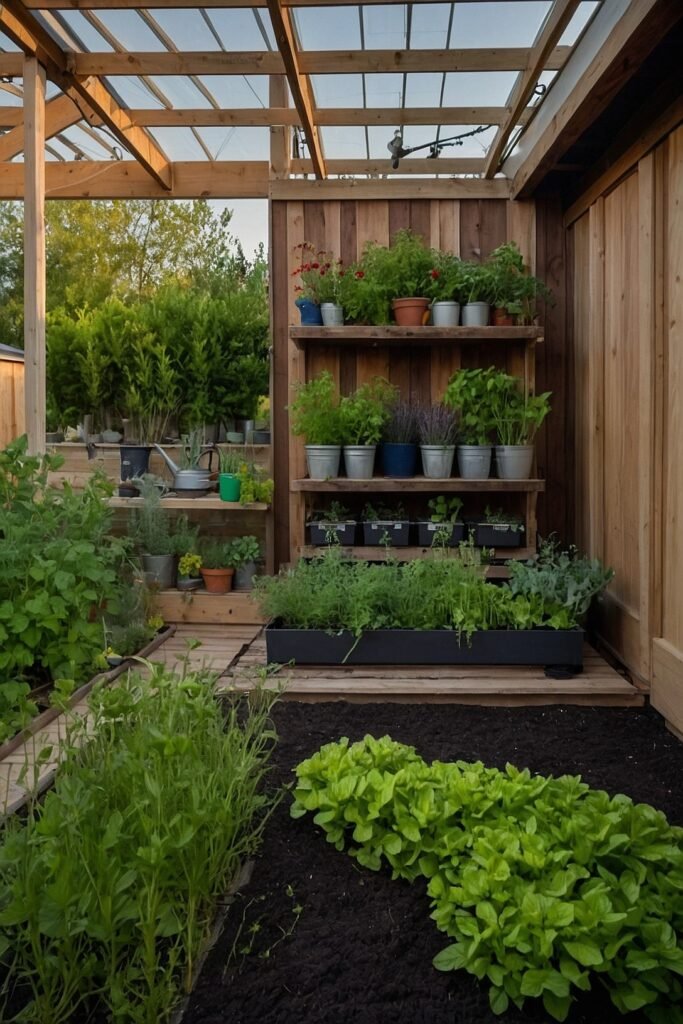
Plant culinary and aromatic herbs around your shed for practical beauty that serves multiple purposes.
You create functional gardens while softening building appearance naturally. Harvest herbs regularly to maintain plant health and productivity.
Choose herbs that thrive in your shed’s specific sun and soil conditions. Group plants with similar water requirements for easier maintenance.
Herb gardens provide practical benefits while contributing to overall landscape beauty and functionality.
10: Rock Garden Border
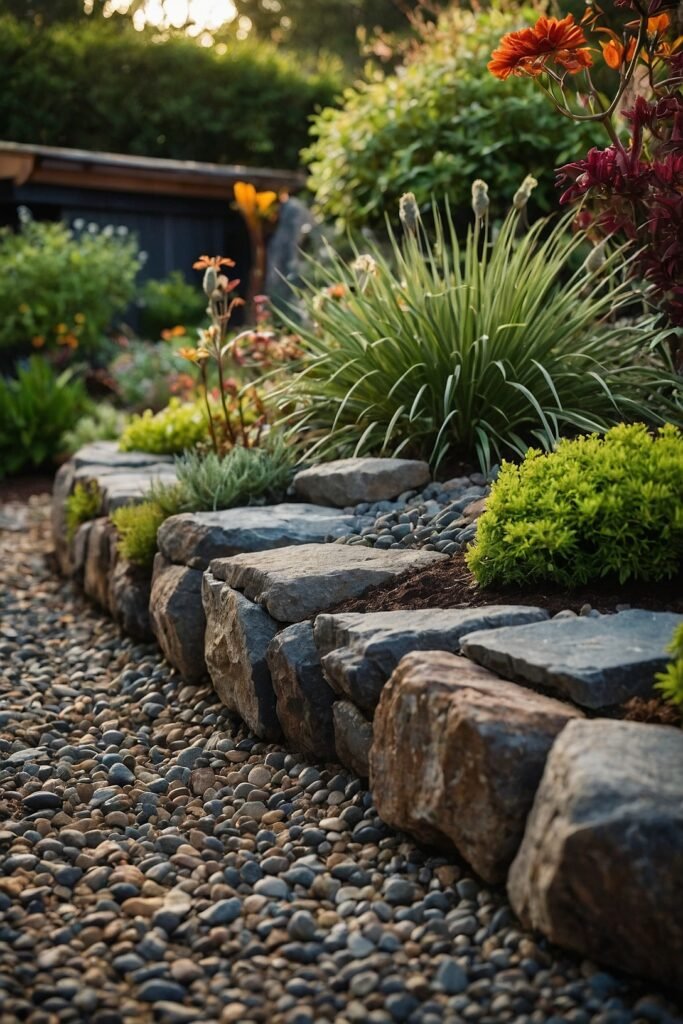
Create rock gardens around your shed using native stones and drought-tolerant plants for low-maintenance landscape solutions.
You establish interesting textures while reducing watering needs. Use varying rock sizes for visual interest and natural appearance.
Arrange rocks in natural-looking groupings with plants nestled between stones. Choose plants that complement rocky environments and local growing conditions.
Rock gardens provide excellent drainage while creating unique landscape features around buildings.
11: Shed Roof Garden
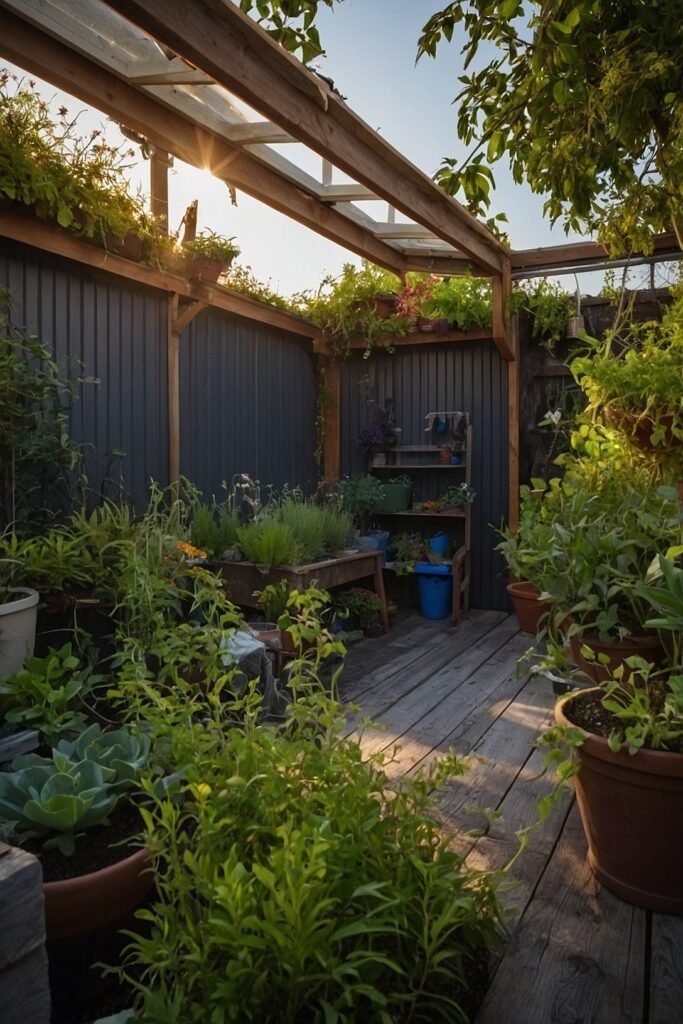
Transform flat or low-pitched shed roofs into green spaces using extensive sedum plantings or container gardens.
You maximize growing space while improving building appearance.
Ensure roof structure can support additional weight before installation.
Choose lightweight growing mediums and appropriate drainage systems for roof conditions.
Select plants suited to rooftop growing conditions and climate exposure. Roof gardens create striking visual impact while utilizing otherwise unused space.
12: Decorative Fence Integration
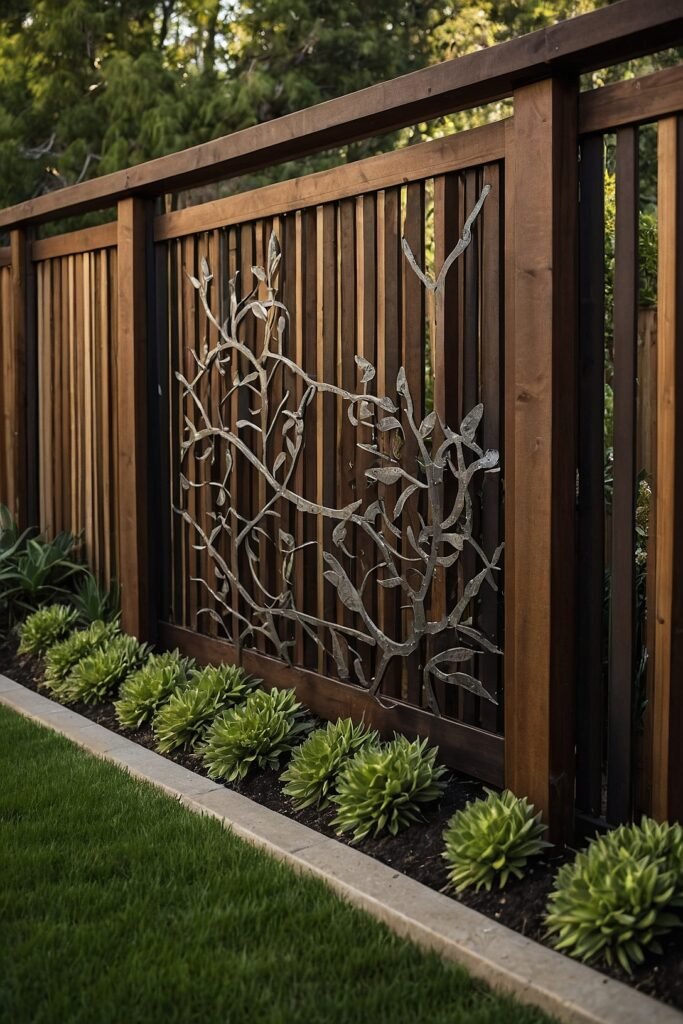
Connect your shed to existing fencing or create new fence sections that incorporate the building into cohesive boundary treatments.
You establish unified property definitions. Add gates or openings for easy shed access from different yard areas.
Match fence materials and styles to existing structures for seamless integration. Use fencing to create outdoor rooms that include shed spaces naturally.
Integrated fencing makes sheds part of overall landscape architecture rather than afterthoughts.
13: Water Feature Addition
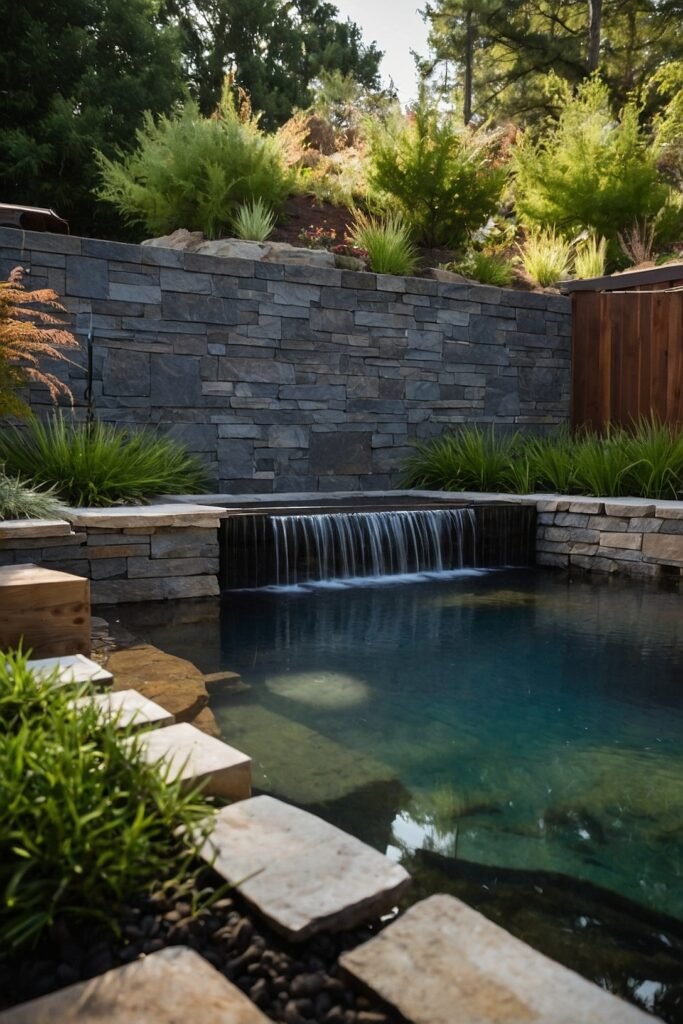
Install small water features like fountains or bird baths near your shed to create peaceful focal points. You add soothing sounds while attracting beneficial wildlife.
Choose water features appropriate for your shed’s scale and surrounding space. Position features where they enhance rather than compete with building presence.
Ensure adequate water sources and electrical connections for pumps if needed. Water elements add tranquil ambiance while masking any shed-related noise.
14: Ornamental Grass Planting

Surround your shed with ornamental grasses for movement, texture, and seasonal interest throughout the year. You create dynamic plantings that require minimal maintenance.
Choose grass varieties suited to your climate and growing conditions. Mix different species for varied heights, textures, and bloom times.
Allow adequate space for grass clumps to reach mature sizes. Ornamental grasses provide four-season interest while softening harsh building lines effectively.
15: Garden Tool Display Area

Create attractive storage for frequently used garden tools near your shed entrance using decorative hooks and organizers. You combine function with visual appeal.
Install tool storage on shed walls or nearby posts for convenient access. Choose storage solutions that complement your shed’s architectural style.
Keep displayed tools clean and well-maintained for best appearance. Organized tool display adds functionality while contributing to overall landscape organization.
16: Themed Garden Creation
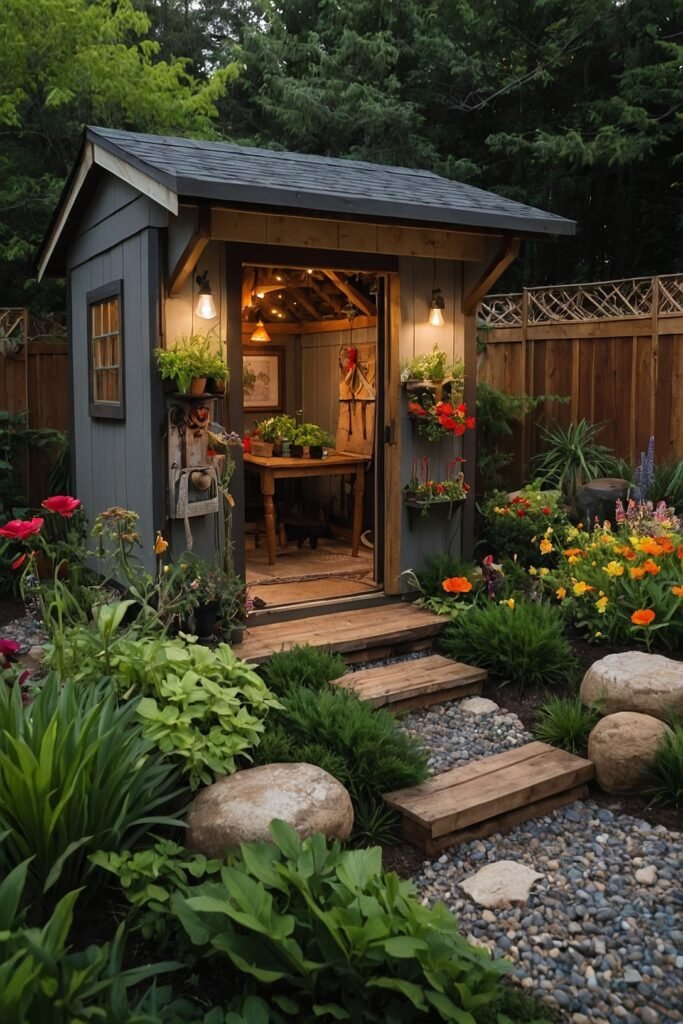
Design specialty gardens around your shed based on specific themes like butterfly, cottage, or native plant gardens. You establish focused growing areas with clear purposes.
Choose plants that support your selected theme and growing conditions. Research plant combinations that provide desired wildlife benefits or aesthetic effects.
Add appropriate decorative elements to reinforce garden themes. Themed gardens create educational opportunities while enhancing landscape diversity and interest.
17: Mulched Landscape Beds

Install mulched planting beds around your shed for clean, finished appearance and improved plant health.
You reduce maintenance while creating professional-looking landscape design. Apply mulch at proper depths for weed suppression and moisture retention.
Choose mulch materials that complement your home and existing landscape features.
Refresh mulch annually to maintain appearance and effectiveness. Mulched beds provide polished looks while supporting healthy plant growth around buildings.
18: Espalier Fruit Tree Training
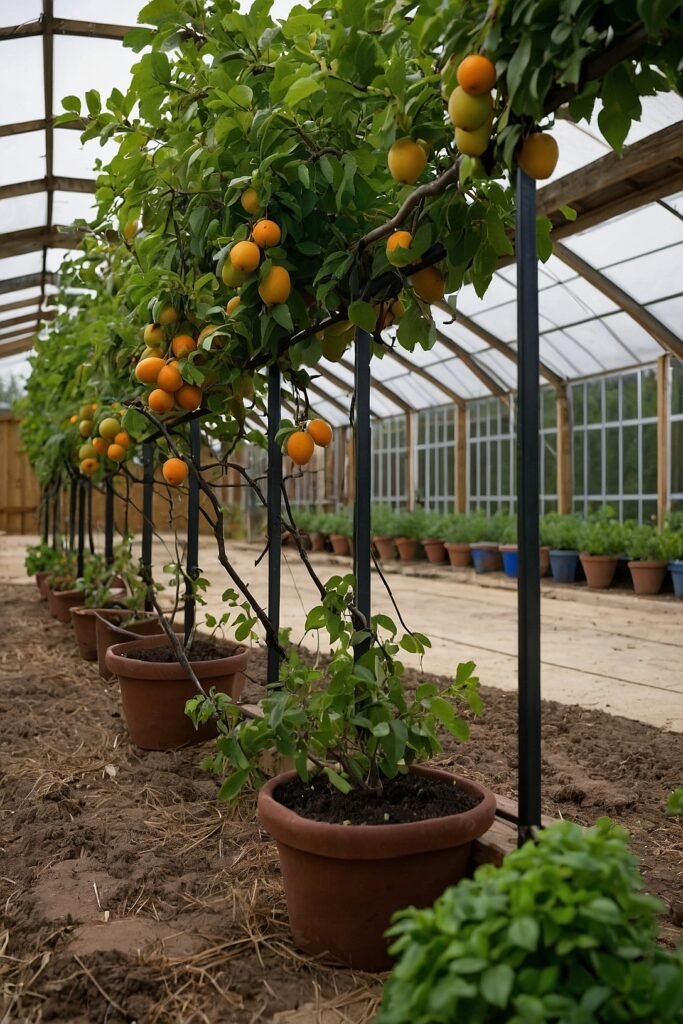
Train fruit trees against shed walls using espalier techniques for productive beauty in compact spaces. You harvest fresh fruit while creating living architectural elements.
Choose fruit varieties appropriate for your climate and wall exposure conditions. Install support wires or trellises for proper tree training and growth.
Prune regularly to maintain desired shapes and productive growth. Espaliered trees maximize growing space while adding sophisticated landscape features.
19: Windbreak Planting
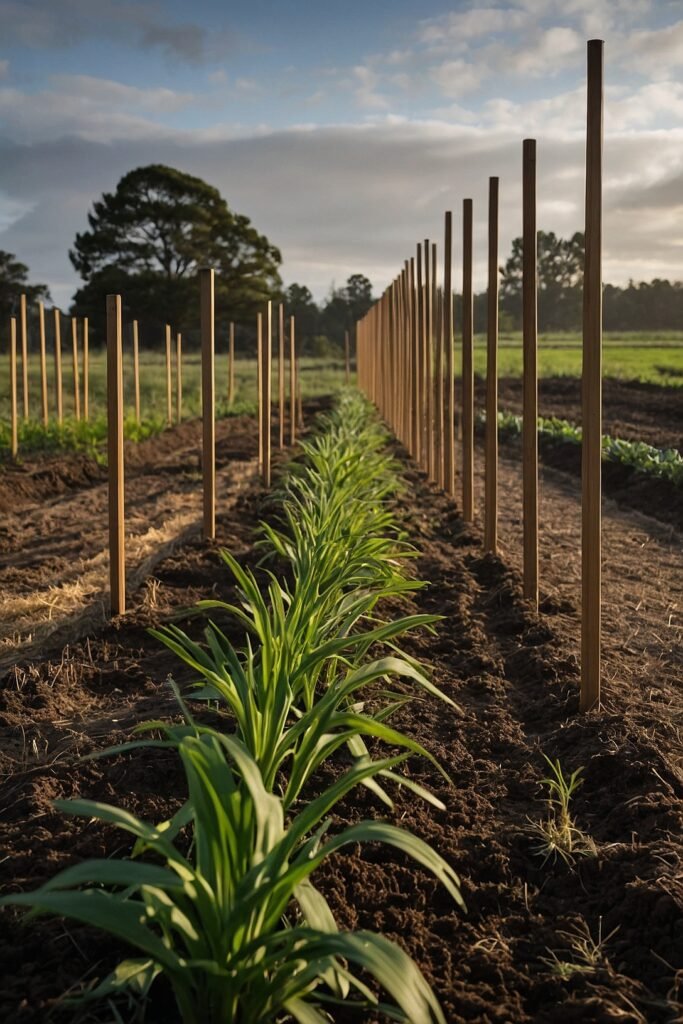
Plant trees or large shrubs to protect your shed from prevailing winds while creating natural screening.
You improve building longevity while enhancing landscape structure. Position windbreaks to deflect rather than completely block airflow.
Choose plants that provide effective wind protection without creating moisture problems.
Consider mature plant sizes when spacing for optimal protection. Strategic windbreaks protect buildings while creating microclimates for other plants.
20: Decorative Lattice Screening
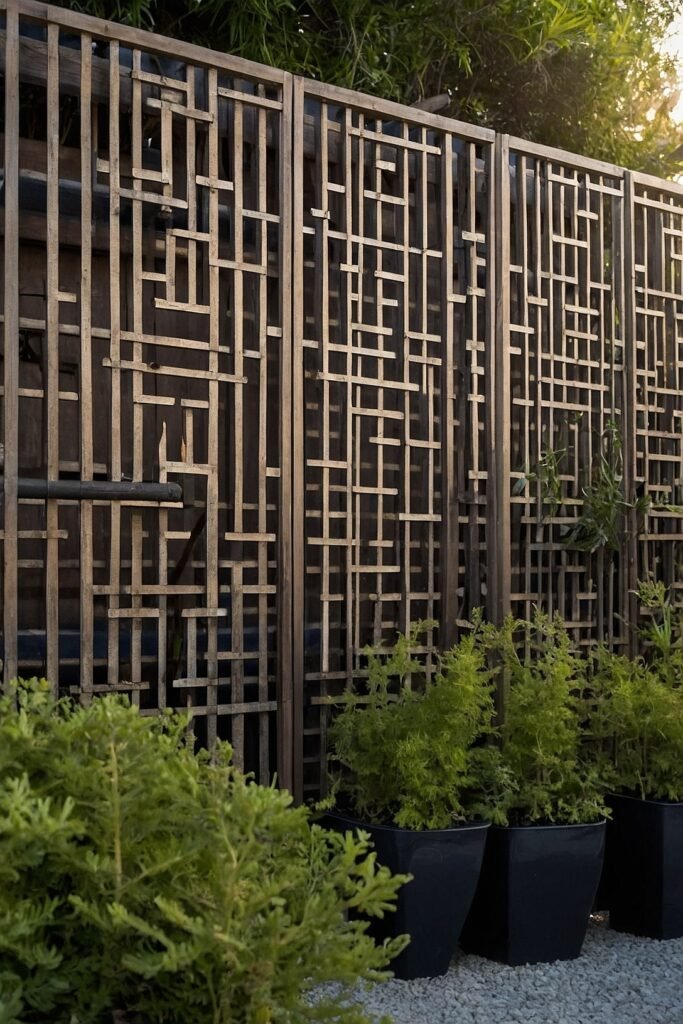
Install decorative lattice panels around your shed base or sides for attractive screening that allows air circulation. You hide utilitarian features while maintaining ventilation.
Choose lattice materials and patterns that complement your home’s architectural style. Paint or stain lattice to coordinate with shed and landscape colors.
Plant climbing vines on lattice for additional beauty and natural integration. Lattice screening provides immediate visual improvement while supporting future plant growth.
21: Cottage Garden Border

Create informal cottage-style plantings around your shed with mixed flowers, herbs, and small shrubs. You establish charming, relaxed garden atmosphere.
Choose plants with extended bloom periods and self-seeding characteristics for natural appearance. Mix colors and textures for abundant, cottage-like effects.
Allow plants to grow naturally with minimal formal pruning. Cottage gardens provide abundant beauty while requiring less precise maintenance than formal designs.
22: Seasonal Bulb Planting

Plant spring bulbs around your shed for early season color and natural landscape awakening. You enjoy blooms before other plants emerge from winter dormancy.
Choose bulb varieties with different bloom times for extended spring display. Plant bulbs in natural-looking groupings rather than formal rows.
Allow bulb foliage to die back naturally for energy storage. Spring bulbs provide cheerful color while requiring minimal ongoing maintenance throughout seasons.
23: Ground Cover Installation
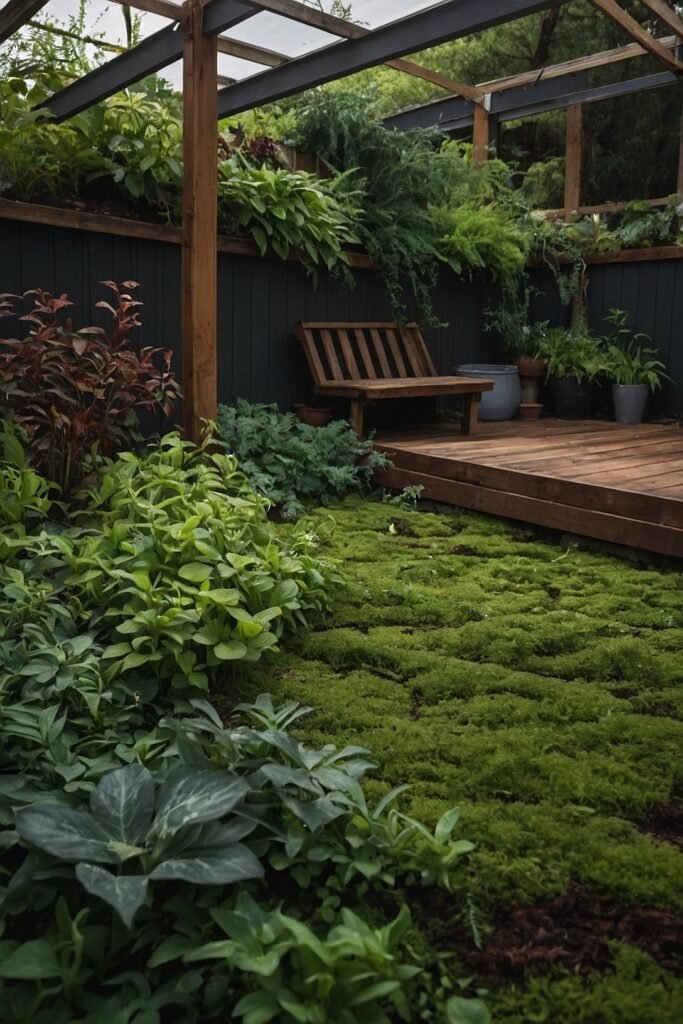
Plant spreading ground covers around your shed to suppress weeds while creating attractive living carpets. You reduce maintenance while adding textural interest.
Choose ground covers appropriate for your shade and moisture conditions. Consider flowering varieties for seasonal color additions to green foliage.
Prepare soil properly for successful ground cover establishment. Living ground covers provide attractive alternatives to traditional mulch or bare soil areas.
24: Vertical Garden Wall

Create vertical growing spaces on shed walls using pocket planters or wall-mounted containers. You maximize growing area while adding living architectural features.
Choose plants appropriate for vertical growing conditions and wall exposure. Ensure adequate drainage to prevent water damage to shed walls.
Install irrigation systems for easier maintenance of wall gardens. Vertical gardens create striking visual impact while utilizing minimal ground space effectively.
25: Sculptural Element Addition
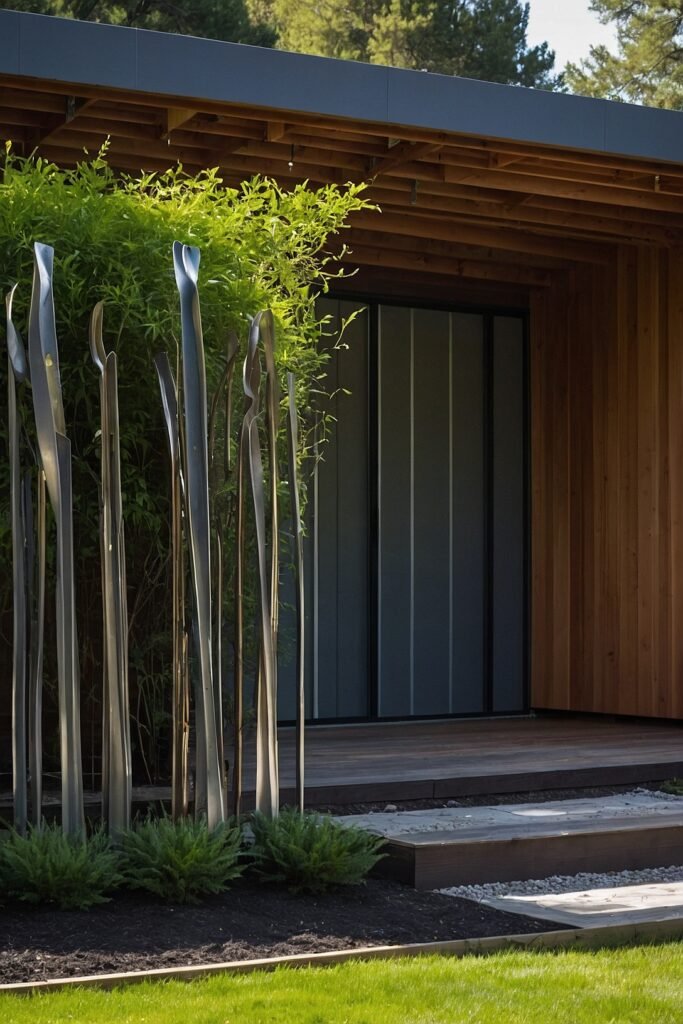
Place garden sculptures, decorative objects, or artistic elements near your shed to create focal points and personality.
You transform utilitarian spaces into artistic landscape features.
Choose sculptures appropriate for your shed’s scale and garden style. Position elements where they enhance rather than compete with plantings.
Consider seasonal sculpture rotation for changing visual interest. Artistic elements add personality while elevating shed areas to landscape destination status.
26: Edible Landscape Integration

Incorporate edible plants like berry bushes, fruit trees, or vegetable gardens around your shed for productive beauty.
Choose edible plants suited to your growing conditions and maintenance capabilities. Position plants for easy harvest access and garden tool storage.
Plan crop rotations and seasonal plantings for continuous productivity. Edible landscapes provide practical benefits while contributing to overall garden beauty and sustainability.
27: Wildlife Habitat Creation

Design plantings around your shed to attract beneficial wildlife like birds, butterflies, and pollinators.
You support local ecosystems while enjoying increased garden activity. Research local wildlife needs for most effective habitat creation.
Choose native plants that provide food and shelter for desired wildlife species. Include water sources and nesting materials in habitat designs.
Wildlife gardens provide educational opportunities while contributing to environmental conservation efforts.
28: All-Season Interest Planning

Select plants around your shed that provide visual interest throughout all four seasons. You maintain attractive landscape features regardless of seasonal changes.
Include evergreen plants for winter structure and deciduous plants for seasonal variation. Add plants with interesting bark, seed pods, or winter berries.
Plan bloom succession for continuous color throughout growing seasons. Four-season gardens provide consistent beauty while maximizing landscape investment returns.
29: Low-Maintenance Design
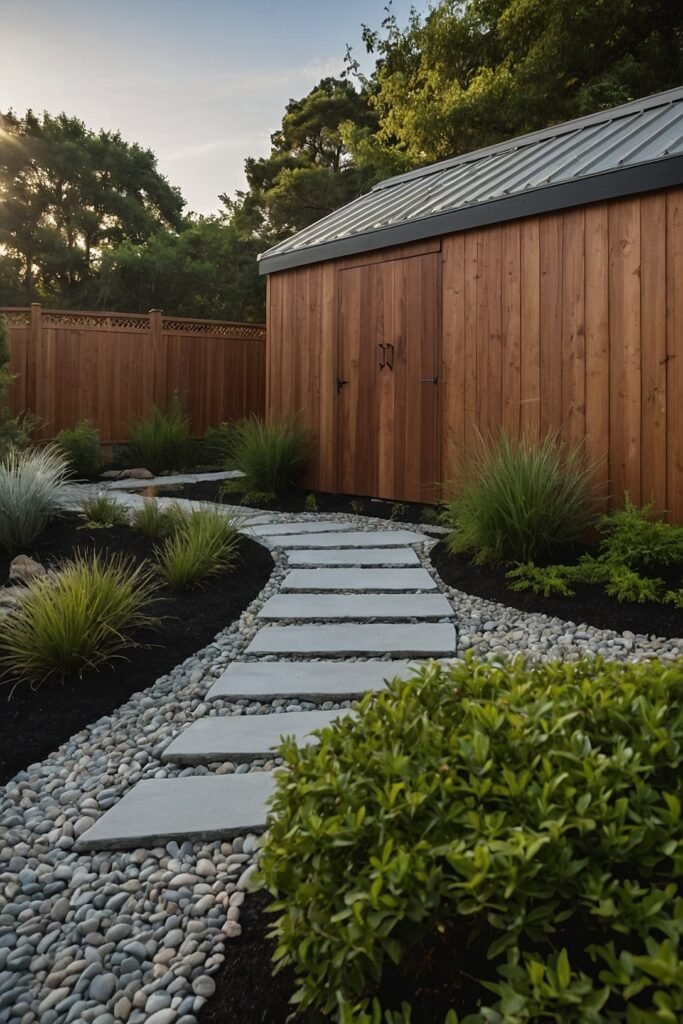
Create shed landscaping using drought-tolerant, disease-resistant plants that require minimal ongoing care.
You enjoy beautiful surroundings without excessive maintenance commitments. Install efficient irrigation systems where needed for plant establishment.
Choose plants native to your region for best adaptation and survival rates. Group plants with similar water and care requirements for efficiency.
Low-maintenance designs provide lasting beauty while fitting busy lifestyle requirements.
Conclusion
These landscaping ideas transform ordinary sheds into attractive garden features that enhance your entire outdoor space while maintaining functionality and adding value.

